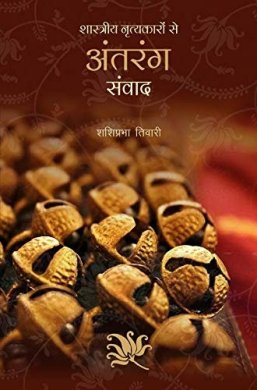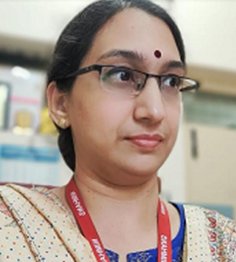
|   |

|   |
An intimate discussion with classical dance exponents - Dr. Aarti Jagannathan e-mail: jaganaarti@gmail.com January 11, 2022  TITLE: Shastriya Nrityakaaron se Antrang Samwaad (An intimate discussion with classical dance exponents) LANGUAGE: Hindi AUTHOR: Shashi Prabha Tiwari YEAR: 2021 PAGES: 382 PUBLISHER: Remadhav Art, New Delhi, India Shashi Prabha Tiwari in her preface sets the tone of the book by blending the concepts of dance and spirituality. She discusses the similarities between a dancer and a 'yogi' (a spiritually evolved person); the aim of both is to attain oneness with the cosmic presence. She terms dance as 'Dharma Sadhana' (duty and meditation) and as a holistic art. She stresses the importance of connection between dance, music and instrumentation in experiencing the zenith. In this book she has made an attempt to talk to Indian classical dance exponents from different decades and has given a glimpse of their personal journey as a dancer. This book captures an 'Intimate Discussion' with 52 classical dance exponents from different Indian classical dance forms such as Kathak (n = 20), Bharatanatyam (n = 13); Kuchipudi (n = 4), Odissi (n = 6), Mohiniyattam (n=4) and Sattriya (n=5). The history of each classical dance forms the preludes of the narrative discussions with its exponents. According to the author, Kathak as a classical dance emerged in the Aryan period and was performed to please the Gods. The sculptures in Ajanta and Ellora, Bhubaneshwar, Khajuraho stand proof of the dance form which meant, 'new' or 'the one who tells the story'. She speaks about the influence of Vaishnav Dharma (tradition in Hinduism) in the style, art and process of Kathak as a dance form. She has also presented a short history of how this dance form changed from being a 'Mujra' (dance performed by a prostitute) during the Mughal era to introduction of use of Sanskrit instead of Hindi language in the Drupad songs sung for the dance performance during King Mansingh Tomar's time. She credits Pt. Bhudadev Maharaj and Pt Kalka Prasad in bringing dignity to this dance form along with Pt Birju Maharaj who brought in a contemporary style to Kathak. The dance form got a new lease after Independence with the establishment of Bharatiya Kala Kendra and Sangeet Natak Akademi where most of the Kathak masters and Hindustani vocalists used to practice and teach together. Ms Tiwari also speaks about the contributions of the various schools of Kathak dance (Gharanas) especially Lucknow Gharana, Jaipur Gharana in propagating this art form. The next few chapters of this section tell us the stories of Kathak exponents and their journey as dancers including that of Pt Birju Maharaj, Sitara Devi, Pt Jitendra Maharaj, Uma Sharma, Munna Shukla, Geetanjali Lal, Shovana Narayan, Saswati Sen, Nalini and Kamalini, Aditi Mangaldas, Urmila Sharma, Malati Shyam, Rajashree Shirke, Rani Khanum, Rammohan Maharaj, Uma Dogra, Sumeeta Sharma, Prathiba Singh, Gauri Diwakar and Rachna Yadav. The next section focuses on the popular dance form of South India, i.e., Bharatanatyam. Ms Tiwari speaks about the reflections of this art form in the sculptures of temples of 14th - 16th century such as Tanjore, Vijayanagara, Hampi, Tiruvannamalai and Vrudhachalam. She also speaks about the underpinnings of this dance form in the 'Devadasi' tradition and how Rukmini Devi Arundale brought dignity to this art form through the establishment of Kalakshetra Foundation, a dance school which encouraged men also to take up dancing. She has quoted dancers who talk of how aspects of Bharatanatyam such as Navarasas (nine emotions) help the dancer to attain peace (shantum) and silence (shunya); this is when dance is considered to be equivalent to meditation. Renowned Bharatanatyam dancers' journeys such as Dr Yamini Krishnamurthy, Dr. Sonal Mansingh, Prof C V Chandrashekar, Dr Vyjayantimala Bali, Hemamalini, Dr. Saraoja Vaidyanathan, Geeta Chandran, Malavika Sarukkai, Alarmel Valli, Dr. Sandhya Purecha, Prathibha Prahlad, Dr Padmaja Venkatesh Suresh and Suhail Bhan have been eloquently narrated in the next few chapters of this section. The Kuchipudi dance form originated in Kuchipudi village, Krishna District of Andhra Pradesh in early 20th century. Ms Tiwari traces the underpinnings of Kuchipudi dance form to the Bhagavata Mela Natakam (drama) of 11th century; hence an important emotion in Kuchipudi is bhakti (devotion) which is often depicted through the narration of story of Krishna and Satyabhama (Bhama Kalapam). She credits Laxminarayan Shastri from Kuchipudi village who spread his wings to Chennai to teach the dance form to enthusiasts outside the state, to propagate this dance form. She also credits Lingeshwar Rao, AV Rao, Tandav Krishna in bringing this dance form to international standards. The next few chapters describe the dance journey of a few exponents of Kuchipudi including Swapna Sundari, Vanashree Rao, Shalu Jindal, and Arunima Kumar. The next section focuses on Odissi, a dance form of East India from state of Orissa. The dance form is observed to have originated from folk and local dance forms such as Mahari, Gotipua, Chhau, Keertan and Rasleela. The author states that dance was an integral part of Orissa culture and was practiced in Sri Jagannath Temple as part of its puja celebrations from many decades. The origins of this dance form are also noticed in ancient carvings and temples such as Udayagiri caves, Konark Sun Temple etc. She reports that in 40's, Cuttack town emerged as the cultural capital of the state with all senior teachers (gurus) culminating to teach the art form. She credits Guru Kelucharan Mohapatra and Guru Pankaj Charan Das in propagating this dance form. The next few chapters in this section detail the dance journeys of Odissi dance exponents such as Guru Mayadhar Raut, Madhavi Mudgal, Ranjana Gauhar, Sujatha Mohapatra, Kavita Dwibedi and Dona Ganguly. Mohiniyattam is a famous South Indian dance form of Kerala and Malabar region. The mythological anecdote of the 'devas' (gods) and 'asuras' (demons) churning the ocean to receive nectar and Lord Vishnu appearing in the form of a beautiful lady 'Mohini' who depicted the Mohini bhava, is an expression that defines the dance form (a lady who bewitches everyone with her charm, beauty and dance). The dance form is observed to use mainly the upper body movements which are slow and circular in nature in keeping with the circular structure of the temples in Kerala. It makes soft use of hand gestures with delicacy. The author traces the history of Mohiniyattam to 2nd century where Chakyar Koothu was performed by men and the ladies performed Mohiniyattam. In 8th century, Mohiniyattam was considered to be performed only by those who danced in Kerala temples belonging to Nangiyar culture. The Maharaja of Travancore, Swati Tirunal who was a connoisseur of dance and art himself is credited with creation of this dance form during his tenure. Initially this art form was restricted to the Nair and Menon community; however it accepted others into its fold and expanded as an internationally renowned dance form over decades. The author has had intimate conversations with four dance exponents of Mohiniyattam in this book including Dr. Kanak Rele, Bharati Shivaji, Jayaprabha Menon and Mom Ganguli. The last section focuses on Sattriya dance, the classical dance of Assam which is stated to have been initiated in the 15th century by Shrimant Sankardev, and his disciple Madhavdev. It is mentioned that in ancient times, every family in Assam took to classical dance and music and the city established the Sattriya Kendra, a cultural centre where dance and music was taught. The aim of this centre was to unite all the people of the Brahmaputra valley through song and dance. Disciples of this centre spread all over Assam state to propagate this dance form. The dance form initially focused mainly on steps, then to emotions especially the Bhakti Rasa (emotion of devotion). The section describes the dance journeys of five exponents of this art form including Guru Ghanakanta Bora, Guru Jatin Goswami, Dr Sharodi Saikia, Anita Sharma and Dr. Anwesa Mahanta. Overall the book is a treat for dance enthusiasts who want to learn about their favourite dance exponents; especially their perspectives on dance, their journey and their messages. The author Shashi Prabha Tiwari needs to be lauded for her effort in contacting each of the dance exponents from all parts of India, learning about their dance forms, its history and narrating it in a simplistic manner in this book for the lay audience. The book has a good easy flow, language and a captivating narrative which helps both dance experts and dance novices to connect with what is written in this book. A few limitations of this book include that it largely focuses on two dance forms and their dancers i.e. Kathak and Bharatanatyam, possibly because they are the prominent and popular dance forms of India. Further, the history of a few dance forms such as Odissi and Kathak have been penned in detail as compared to others which are presented relatively in a sketchy fashion. For e.g: the traditional dance schools in Bharatanatyam of the Tanjore style find no mention in this book. Classical dance forms such as Manipuri and Kathakali have been left out and find no mention even in the foreword. These lacunae could be filled in the next edition of this book, as dance lovers and dance novices would like to have a compendium of the history of each of the Indian classical dance forms and their exponents in the future. Such a book has not been written till date and would be a valuable asset in history of Indian classical dance.  Dr. Aarti Jagannathan is currently working as an Additional Professor of Psychiatric Social Work / Psychiatric Rehabilitation Services at National Institute of Mental Health and Neurosciences (NIMHANS). Her areas of interest include Rehabilitation of patients with psychiatric disorders, Yoga for mental health, dance and spirituality, caregiver interventions. She is a trained Bharatanatyam dancer for the past 30 years (currently performing and continuing dance training) under the tutelage of Sri Rajarajaeswari Bharatanatya Kala Mandir, Mumbai and Aatmalaya Academy, Bengaluru (Dr Padmaja Suresh). She has more than 75 publications to her credit in national, international journals and books. Post your comment Please provide your name and email id when you use the Anonymous / blog profile to post a comment. All appropriate comments posted in the blog will also be featured in the site. |